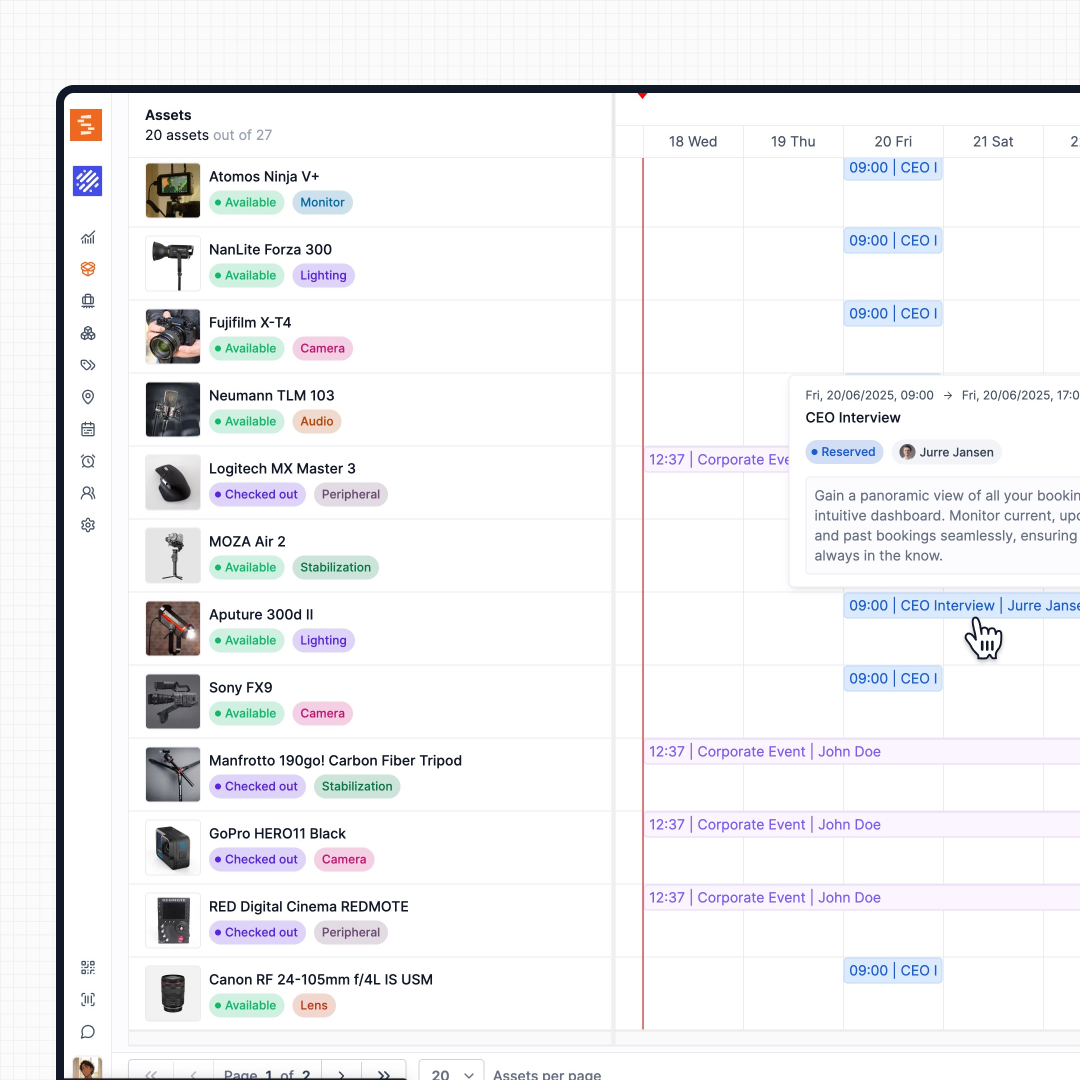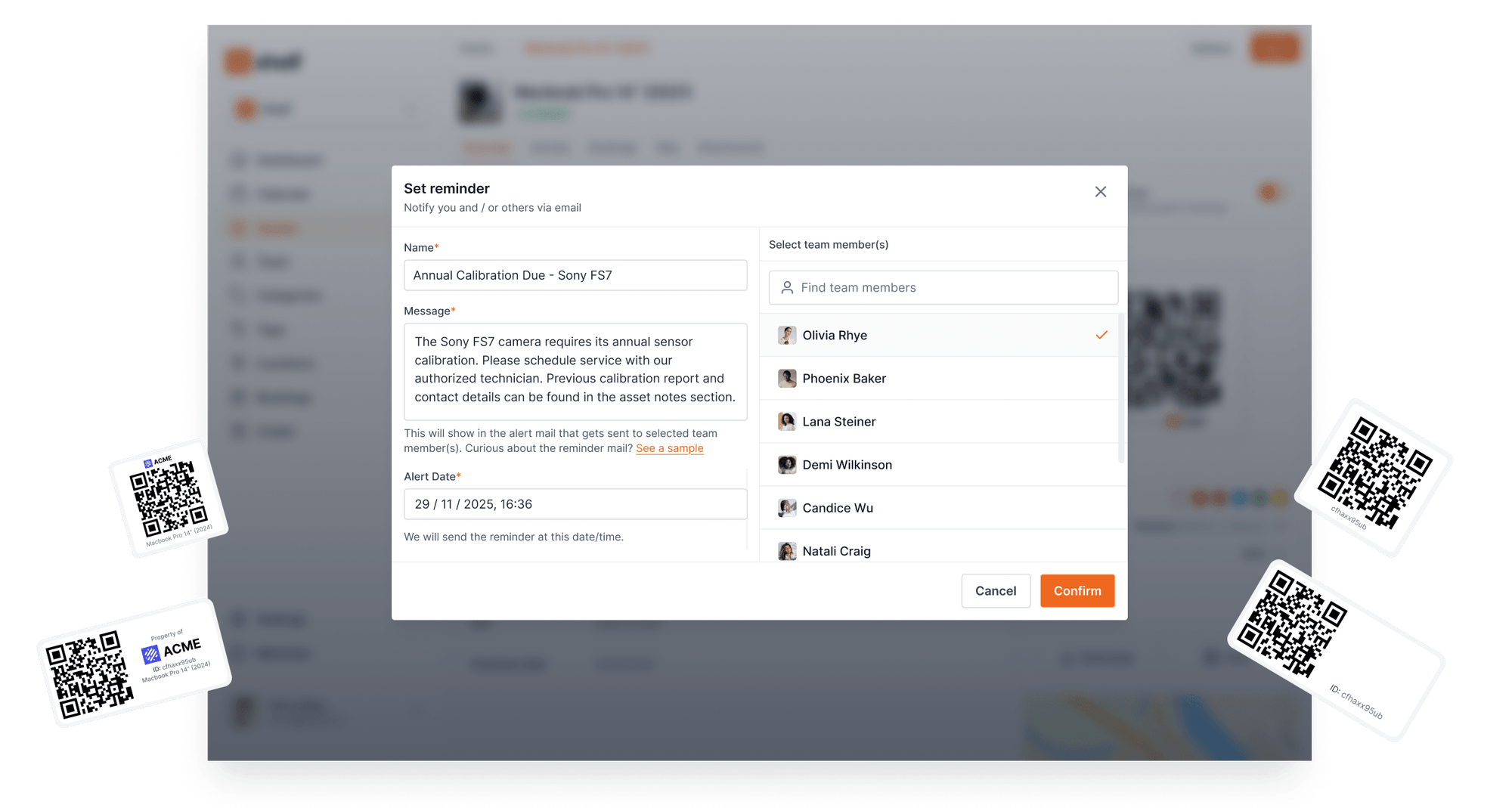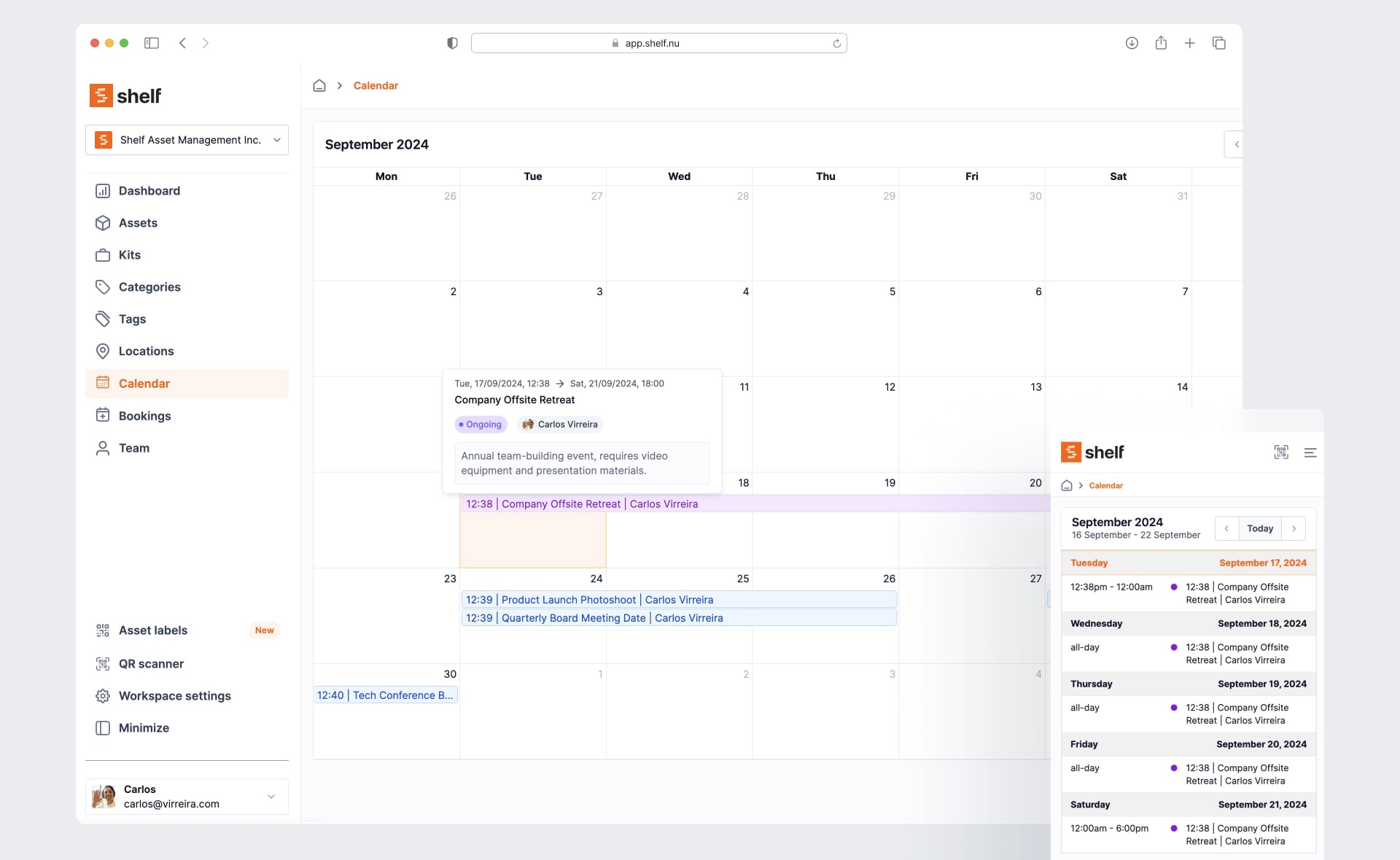Written by
Carlos Virreira
Published on
November 24, 2025
Film schools and media programs juggle hundreds of cameras, audio kits, and lighting rigs that constantly flow between courses, sets, and student projects. Without a structured policy, even the best cage managers battle bottlenecks, lost lenses, or scheduling conflicts that derail productions. This guide consolidates proven practices from campus equipment rooms, fills gaps left by scattered institutional playbooks, and shows how Shelf’s platform helps document workflows, automate reminders, and drive accountability without resorting to guesswork.

Film schools and media programs juggle hundreds of cameras, audio kits, and lighting rigs that constantly flow between courses, sets, and student projects. Without a structured policy, even the best cage managers battle bottlenecks, lost lenses, or scheduling conflicts that derail productions. This guide consolidates proven practices from campus equipment rooms, fills gaps left by scattered institutional playbooks, and shows how Shelf’s platform helps document workflows, automate reminders, and drive accountability without resorting to guesswork.

Academic equipment rooms routinely absorb industry-style demands, yet a lack of consolidated best-practice frameworks across film schools leaves many managers improvising.
Publishing a unified playbook keeps staff aligned on reservation logic, inspection routines, and escalation paths, giving students predictable access that mirrors professional set etiquette.
Linking operations back to standards from organizations like EDUCAUSE helps justify policy decisions to academic leadership and ensures compliance reviews are backed by sector-wide guidance.
Shelf’s camera equipment check-out solution provides a template-based structure that departments can adapt rather than reinventing every rule for each semester.
Programs typically require completion of foundational production courses, a signed usage contract, and proof of current enrollment before issuing advanced kits. Some schools also tie eligibility to GPA thresholds or faculty recommendations for specialty gear like Steadicams.
Because course rosters and prerequisites change often, eligibility criteria should live in a single reference document inside Shelf so staff avoid conflicting versions spread across shared drives. Exportable rule summaries help advisors counsel students early, reducing disputes during crunch-time pickups.
Clear reservation windows prevent single projects from monopolizing inventory. Many schools allow seven-day camera loans, shorter windows for lighting due to maintenance needs, and extended loans only with faculty approval.
Publishing caps on simultaneous reservations and blackout periods for institutional events keeps scheduling transparent. Shelf’s policy pages can embed calendar screenshots so students understand when high-demand items are unavailable, decreasing last-minute escalations.

Every student should sign an annual responsibility agreement that outlines safety, compliance, and the expectation to attend cage orientations. Digital signatures collected within Shelf tie each clause to the student ID, allowing staff to prove that policies were acknowledged. Workshops must cover standard handling, documentation practices, and what to do if a shoot wraps outside cage hours. Recording attendance protects the school when enforcing policies, especially when restricting access for noncompliance.
Insufficient emphasis on accountability and financial liability processes leads to confusion when gear returns late or broken. Itemized liability clauses should specify replacement cost, processing fees, and how charges appear on student accounts. Integrating these terms into Shelf’s Custody chain view creates an auditable record of who handled each asset and when, allowing finance teams to invoice with confidence. Clear instructions about reporting losses within 24 hours reduce the temptation to hide issues until inspections uncover them.
Cage staff must document baseline condition with photos or checklists before release, then verify every piece—down to batteries and cables—upon return. Requiring students to walk through the checklist reinforces shared responsibility and teaches professional wrap habits. Shelf’s inspection templates capture notes and images, building a historical log for each kit. When multiple incidents involve the same user, staff can escalate training requirements or suspend access until remediation is complete.

A comprehensive packing checklist ensures that students leave with everything they need, reducing mid-shoot support calls. Include firmware versions, formatted cards, charged batteries, and labeled cases. Shelf can curate these checklists from multiple universities, addressing the current lack of consolidated references and letting managers benchmark their procedures. Posting checklists near prep tables reinforces consistent expectations even when student workers rotate shifts.
Pickup should require institutional IDs, confirmation of training status, and verification that no outstanding fines exist. Many programs photograph the student with the packed kit to document the handoff. Embedding ID verification steps inside Shelf’s workflows keeps data centralized instead of scattered across paper forms. Documenting exceptions—such as faculty overrides—prevents ambiguity during audits.
Return workflows must accommodate both scheduled hours and after-hours drops. Provide clear instructions for locking gear, labeling issues, and notifying staff via form or app submission. Automated reminders triggered 24 hours before due time and again at the deadline reduce late returns dramatically. Communicating how late fees escalate encourages proactive communication, and staff should have authority to adjust penalties when weather or institutional closures intervene.

Limited discussion of digital reservation systems in traditional policy documents leaves many programs reliant on spreadsheets or inbox requests. Moving to an online scheduling platform ensures students see real-time availability and prevents double entries. Shelf’s Bookings feature enforces rules by course, automatically rejects conflicting requests, and removes the manual back-and-forth that consumes staff hours. Because bookings map directly to asset barcodes, there is never a question about which serial number was promised to which student.
To keep high-value equipment accessible, managers must visualize reservations across class sections, capstone films, and institution-wide events. Shelf’s Why We Built Availability View article explains how a timeline-style calendar reveals conflicts before they escalate. Embedding the same availability insights in cage operations prevents double bookings and gives faculty confidence that critical shoots will not lose access at the last second. This visibility also supports proactive maintenance scheduling because staff can block off windows to service gear without disrupting confirmed reservations.
Even the best system requires human oversight. Staff should review flagged reservations daily, confirm that students have completed training, and check for special permissions on drones, gimbals, or specialty lenses. By annotating each booking with approval notes, managers maintain an audit trail for accreditation reviews. Shelf enables staff to assign tasks or comments to individual requests, ensuring nothing slips through when teams change shifts or when adjunct faculty manage weekend productions.

Detailed equipment logs underpin maintenance planning, depreciation tracking, and curriculum support. Linking each asset to purchase data, current valuation, and recent issues helps programs justify replacement budgets to procurement teams referencing Gartner Intelligent Asset Management Reviews. Centralizing logs inside Shelf — built on our asset tracking foundation — eliminates duplicate spreadsheets and lets technicians run utilization reports that inform future kit builds. These logs also highlight which items require proactive maintenance before heavy production periods.
Few resources address communication workflows even though reminders dramatically improve return rates. Shelf automates pickup notices, due-date reminders, and overdue escalations through email or SMS so staff are not drafting individual messages. Students learn to expect these nudges, reducing the chance of accidental late returns during finals or festival season. Managers can also trigger broadcast messages when weather closes campus or when a firmware update is required before the next shoot.
Workshops work best when tracked like reservations. Using Shelf to publish schedules, capture attendance, and link each session to the equipment families it certifies helps prevent training gaps. Embedding tutorial videos or SOPs within the training record gives students a reference long after the workshop ends. This approach answers the demand for better communication workflows by ensuring every user receives the same instructions, even when staff rotate or graduate assistants manage sessions.

Film schools often require students to provide proof of personal production insurance for external shoots, while the institution carries blanket coverage for on-campus use. Policies should clarify deductibles, reporting procedures, and how coverage differs for alumni productions. Linking insurance documents within each booking keeps expectations visible, and providing template language expedites purchase approvals. Whenever possible, coordinate with university risk managers to review coverage annually so cage policies stay aligned with institutional requirements.
Safety briefings must cover ergonomics, rigging, electrical loads, and transport protocols. Documenting these guidelines and embedding them into each booking confirmation reinforces compliance. Encourage faculty to dedicate class time to safety walk-throughs before major shoots so students hear the expectations more than once. Pairing the guidelines with short quizzes inside Shelf helps confirm comprehension and gives staff a record of who passed.
Consistent enforcement keeps policies credible. Establish a tiered response: written warnings for minor lapses, temporary suspension for repeated infractions, and administrative review for negligence or intentional damage. Logging each step within Shelf ensures fairness, especially when new staff inherit existing cases. Include an appeal process so students can contest penalties, and outline who adjudicates disputes to maintain transparency.

Shelf unites reservations, inspections, training records, and communications into a single workflow, eliminating the patchwork of spreadsheets, forms, and email chains that many cages still rely on. The platform addresses the limited discussion of digital scheduling by surfacing live availability, attaching documentation to each booking, and syncing check-in data with maintenance logs. Departments also gain a centralized reference for policies, solving the long-standing gap where each class or faculty member interprets rules differently.
Digital custody tracking ensures accountability follows the asset, not just the student. When kits move between classes, Shelf records each transfer so liability remains clear even if multiple teams share gear within a day. The Workspaces feature lets departments create dedicated virtual rooms for editing labs, sound stages, or media centers so staff can manage bookings by location. This segmentation supports student equipment accountability by clarifying which supervisor is responsible at each handoff.
The Fabel Film case study demonstrates how structured booking tools eliminate double bookings and improve utilization. By adopting Shelf, the studio replaced ad hoc memory-based scheduling with a transparent system that every producer could trust. Film schools can borrow the same playbook: centralize reservations, enforce policy-based approvals, and monitor utilization reports to inform purchasing decisions. Close each term by reviewing trends, updating policies, and sharing wins with leadership so momentum continues.
Bring the same clarity to your campus workflows by unifying policies, bookings, communications, and custody records in a single system built for creative education.
Join 3,000+ teams already running smoother operations—set up in under 30 minutes and see results right away.





